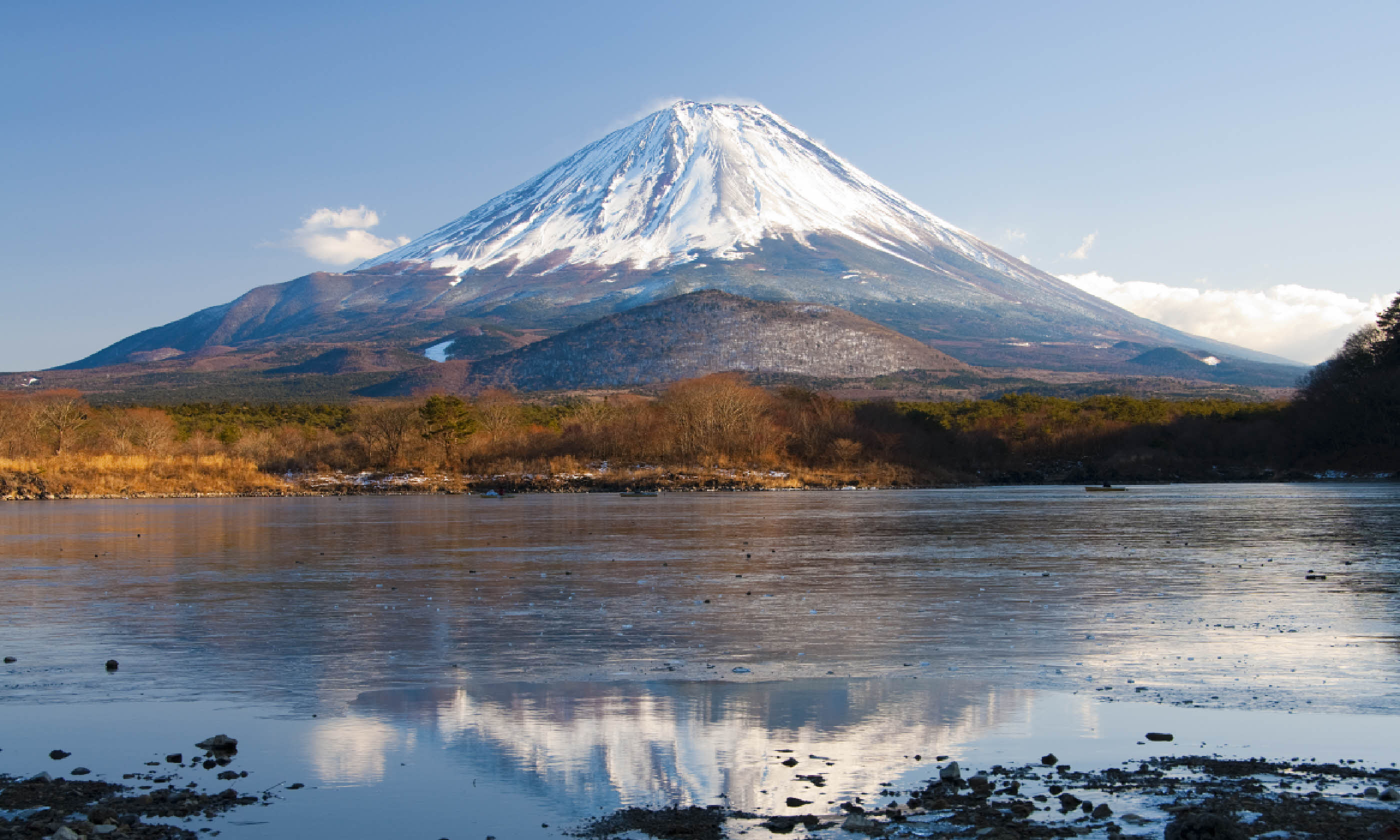
Hiking up Mount Fuji
This is the most classic adventure you can have in Japan. Here's how best to climb this elusive peak and snaffle the most precious views
Fuji is everywhere in Japan. Literally everywhere. Well, perhaps not literally, but figuratively its triangular cone seems to permeate every facet of Japanese culture.
From the Hokusai print on the front of the Japan Rail card I picked up from the station in Tokyo, to the plates on the souvenir stands in nearby Hakone, to the line drawing on the 1,000 yen note, this 3,776m stratovolcano’s seemingly perfectly symmetrical likeness is practically inescapable.
Funny then that on my arrival into Fuji-Hakone-Izu – the national park in which the great mountain sits – I couldn’t see it anywhere. Not an outline, not a cheeky tip peeking from the haze – nothing.
I knew where it should be. A poster at the station helpfully pinpointed its location amid a panorama of lakes and peaks, and the taxi driver who took me to the start of my hike gestured to its supposed summit, describing snow-capped majesty and oblique slopes of ash. But all I could see was an endless grey sky.
“At least we can’t see how far we have to go,” said a fellow walker optimistically as we left the air conditioned comfort of the car and hit the trail, following signs for ‘Fuji Summit’.
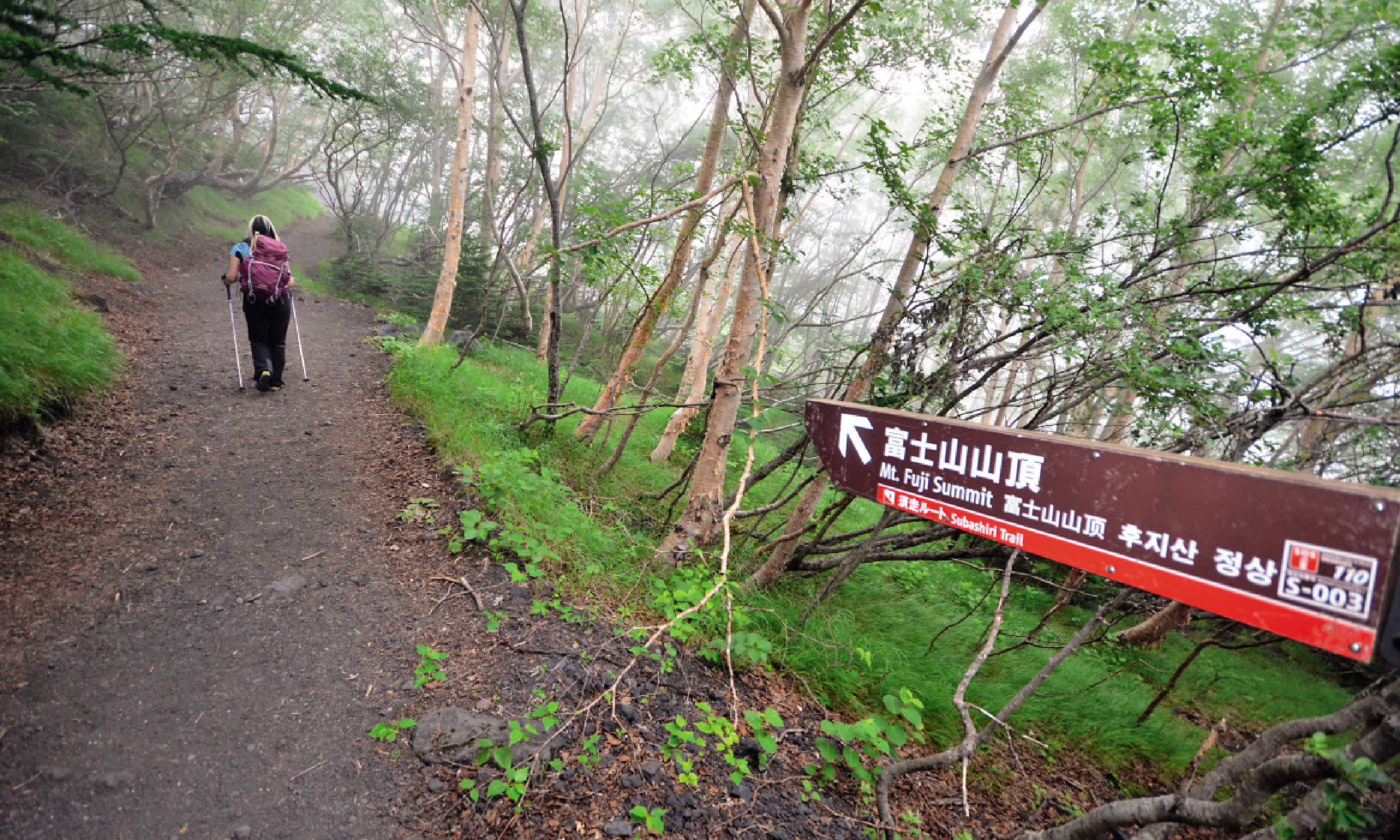
The first recorded ascent of Fuji was in AD 663 by a monk on a pilgrimage. Back then he would have started his climb from one of the towns at the mountain’s base, taking his time to call at temples en route, savouring each moment to reach the high point.
But a lot has changed since then. While technically you can still begin lower down at one of the first of Fuji’s ten ‘stations’ (height levels that feature mountain huts as opposed to railway stops), paved roads make it a less attractive prospect. Most people begin instead at one of the four 5th stations, which sit between 1,440m and 2,400m.
Setting out from Subashiri
We’d decided to start at the 1,930m Subashiri station. From here, there’s still a fair amount of ascent to complete compared to hikes from the most popular Yoshida station (2,305m; always busy due to its ample car park and accommodation) and Fujinomiya (2,400m; highest and second most used), but less than the least-favoured, fairly featureless Gotemba (1,400m). Subashiri is also less developed, and after carb-loading and facility-using at the small shop and restaurant we were on our way without any crowds.
After passing through the
torii gate at a small shrine – where guide Steve advised us to pray for a good climb and good weather – the wide concrete slabbed path faded and we were plunged into a forest of Japanese hemlocks and Nikko fir trees.
Despite the cloud hiding the mountain, it was a hot and humid July day (official climbing season is July-August, when Fuji is usually snow-free and the mountain huts are open) and I was glad of the cover the canopy provided. The air was damp and musky as I clutched the cool, rough bark of a tree trunk to heave myself upwards as the trail became steeper.
With an estimated ascent time of around five hours on this path (and a faster descent of two to three hours), doing Fuji in a single day is certainly possible. But then you’d miss the
goraiko (the ‘arrival of the light’) at sunrise – the ultimate Fuji spectacle.
Therefore most people do the climb in one of two ways: either starting their walk at night and climbing the whole way in the dark to arrive (hopefully) in time for this phenomenon or climb most of the way in the afternoon, rest for the night in a mountain hut, and climb the final few hundred metres before dawn. With no eagerness to stumble around the mountain tired and view-less with the real potential of getting lost, I opted for the latter.
And so I continued to plod, slowly but steadily, on the increasingly rocky Subashiri Trail, knowing that in a few hours I would be able to rest and eat just 376m below the mountaintop.
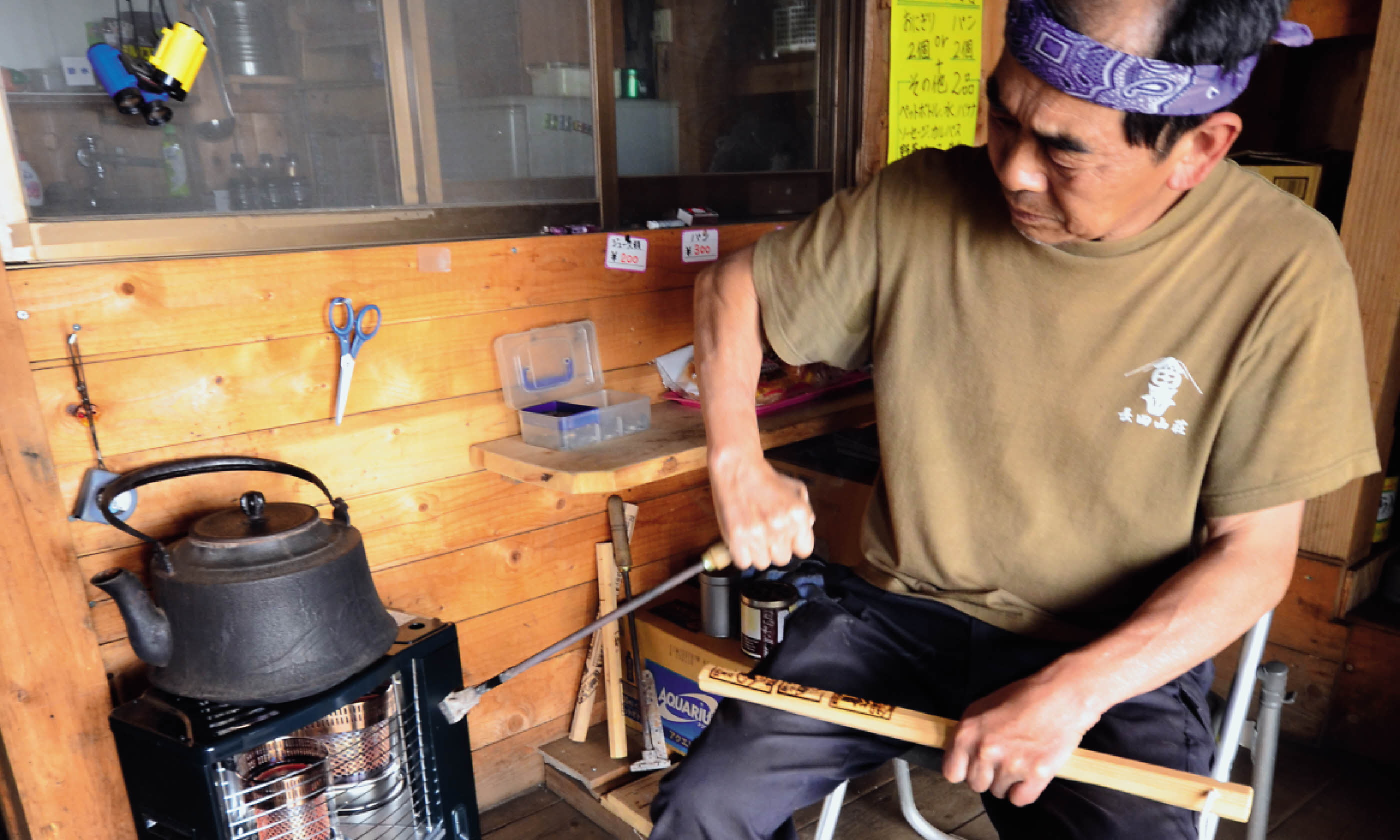
Footsteps up Fuji
Fuji’s volcanic nature soon became clear as we emerged from the forest and onto crumbling ashen cliff s, black and biscuit-like. At the 6th station I reached my first hut and felt around to the side of my pack to grab the small wooden stick I’d bought at the start. For a small fee this baton could be branded with a stamp at each station, providing a pole passport of your journey.
It was supposed to act as a memento to prove you’d made it right the way to the top, but for me it soon became a goal to spur me on – a job to tick off the list; just two more stamps and I’ll be able to rest. The scent of burning wood was satisfying; I stashed my freshly marked stick back in my rucksack and continued on.
Until this point my one constant had been the cloud, concealing any views of the summit like a restrictive but nonetheless comforting blanket. So it was with shock that I turned onto one of the path’s switchbacks a few minutes later and caught sight of blue sky. In just a few steps we had emerged from the clag, popped up above the mist and now looked down on a thick bank of cumulus clouds.
By the time I reached the next hut, the next stamp and the next toilet, the sun and the price of a can of cola had all increased. I sipped my drink watching the azures above me give way to purple, while a smiling Japanese woman branded my walking stick with a hot iron.
Women didn’t used to be allowed on this mountain at all. Fuji was believed to be the home of a fire goddess who, out of jealousy, would spew molten lava towards members of her own sex. Thankfully she has seemingly mellowed – the last eruption was in 1707-8 and women have been treading her pathways in their thousands since 1868.
I met at least a hundred of them not long after the hut, when the Subashiri pathway joined with the busy Yoshida Trail at 3,380m. For the last section of the hike to Hon Hachigome Tomoekan hut (3,400m), the pockets of people became giant clusters, all looking nervously at the summit above, which appeared as a long stretch of steep slope yawning ever upwards.
Inside the hut, a supper of meat curry and rice (oddly, with a burger on the side) awaited. There were also turnstile toilets that set you back ¥200 (£1) a visit and giant bunkbeds where we’d all be sleeping sardine style – the price of climbing the highest mountain in the country.
I didn’t rush in; instead I stood outside on the balcony, which was precariously cleaved into the sharp rocky slope, and stared in awe as I noticed a pointed silhouette stretch out onto the clouds below – my first glimpse of Fuji.
Japan’s greatest high
Despite wearing earplugs, movement from the opposite bunks woke me at 2am. Sunrise wasn’t until just before 5am, but some people were taking no chances. I tried to doze for a little longer but finally, at 3am, with nearly every other walker stirring and lights being switched on, it became impossible.
Sleepily I dressed and bundled my belongings into my bag. I emerged outside to be hit with the chill of pre-dawn air, but it wasn’t just the temperature that took my breath away. As I looked down the mountain, a giant neon caterpillar seemed to be making its way up. Headtorches, flashlights and glowsticks cut through the darkness like Christmas lights. Behind me, Yamabushi monks began to chant while other walkers shook bells and talked excitedly.
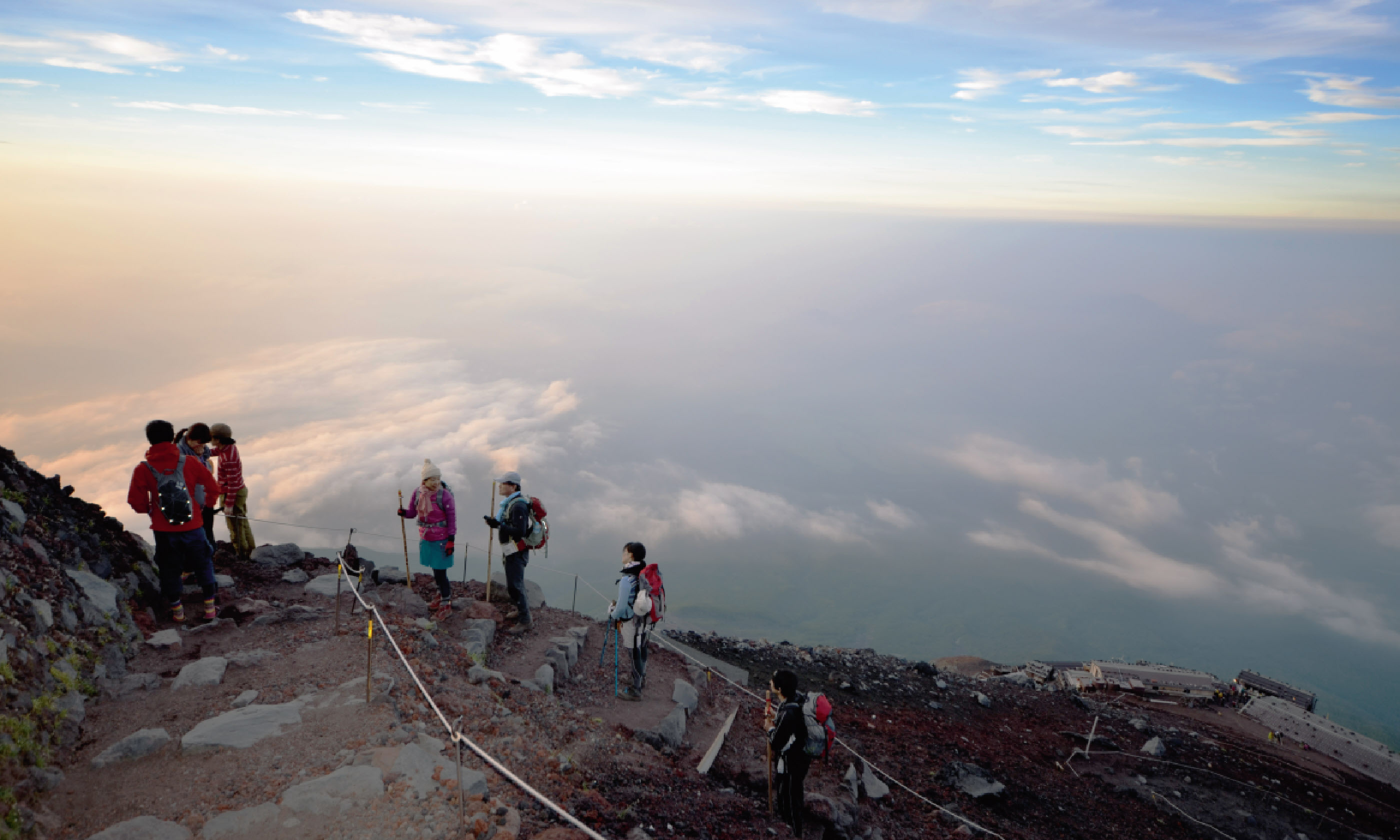
“I’ll see you at the top,” I called to Steve as I was swept up into the torchlit conga weaving its way uphill. I had dreaded the thought of the crowds but, in a funny way, the mass of people became part of the event. People helped each other negotiate steeper passages, and the strobing lights lent a festival vibe to proceedings.
As we hit the 9th station and the white torii gate, just metres from the volcanic crater rim, the chanting monks got louder. Suddenly the bottleneck escaped the narrow trail passage and I was released onto the summit ridge in front of the Kusushi Shrine where the final stamp awaited.
I had done it in good time – sunset was still a good 45 minutes away and now, out of the embrace of the throng, I shivered. Rather bizarrely, at this point of the circular rim sits a cluster of shops, whose owners were madly scrambling to open and showcase their wares to the first wave of arrivals. At first I was unsure what to make of the scenario – being greeted by a raft of vending machines wasn’t something I’d expected atop Japan’s highest peak. But my thirst quickly gave in and I too joined the line to grab a coffee.
Sunrise strolls
The top of Fuji is a circular rim around the volcanic crater. Most summiteers grab a bench, watch sunrise and then descend, but I was determined to complete the hour-long circuit on the Ohachimeguri Trail around the rim.
Warming my hands on my hot drink, I continued on the path to find a spot away from the other walkers bunched near the arrival point. With the key moment imminent, I sat in silent contemplation, watching the dance of the never-ending headtorches still streaming up from below.
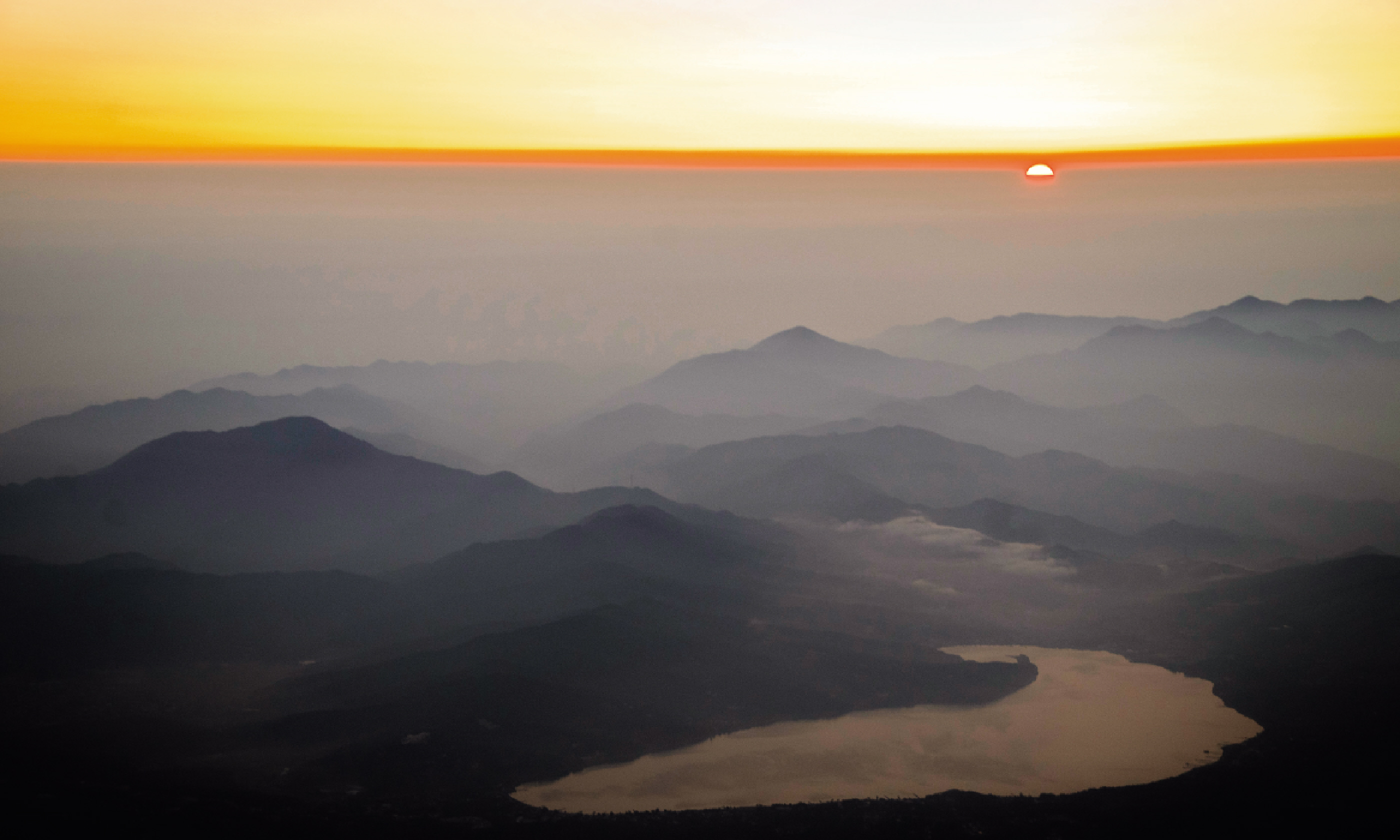
A few minutes before 5am a glow appeared on the horizon, barely a tangerine smudge. Then it began to grow, appearing as a thin line, then a perfectly round orb, intensifying, expanding, lifting. Cheers began to sound from every direction; people hugged, smartphones snapped. The rocks around me turned red as the sunlight broke through the darkness –
goraiko had come.
Reunited with Steve, we celebrated our good weather fortune by continuing along the crater’s pathway, while many groups opted to begin the descent. We passed the post office (I certainly don’t envy the person who has Fuji summit on their round), and spotted each of the five lakes that surround the mountain’s base, barely distinguishable beneath a thin film of haze. Finally we reached it – Kengamine Peak, the mountain’s highest point, the true top.
Passing alongside the now automated weather station, which until its closure in 2004 was manned for 72 years to detect typhoons, I stood triumphantly at the summit marker, a simple granite post engraved with Japanese
kanji (characters) proclaiming it as Fuji’s tip.
Now in full daylight, we walked towards the path that would take us back down the mountain. However, before I left the summit I took one last gaze out at the Kanto plain below. Stretching out over the green was the perfectly symmetrical shadow of Fuji, making its mark on the country below.
It would be the last time I saw the mountain’s profile on my visit. Cloud drifted in not long after and I never did catch a proper view of it – not from my run down Osunabashiri (the ash-covered path that allows what takes hours to climb to be descended in merely 30 minutes); not from the taxi that picked me up at Subashiri Station; not from my hotel at Hakone. But though I never got to see that famous postcard view from the ground, I didn’t care. The silhouette of Fuji I witnessed from the summit was stained on my soul, perfectly symmetrical and forever inescapable.
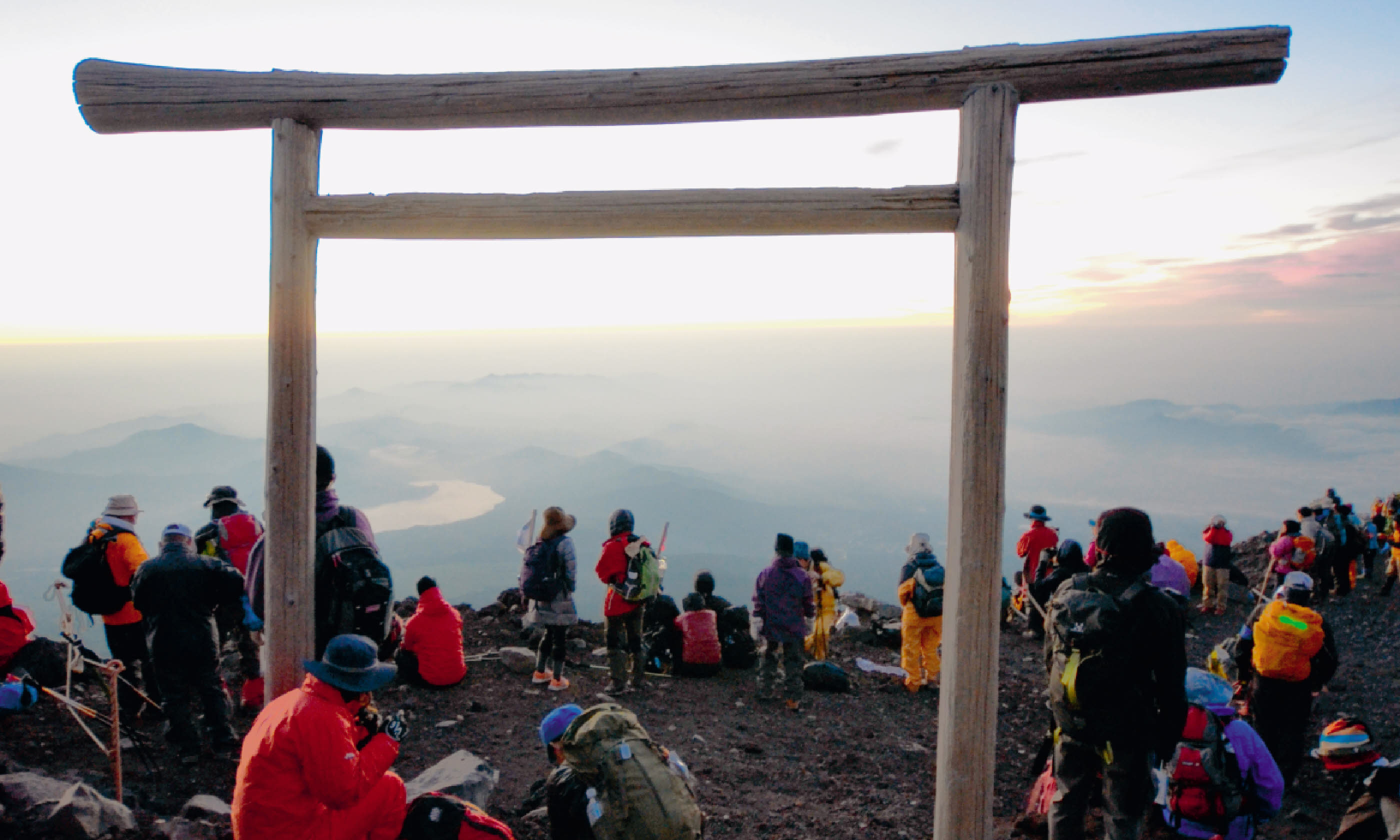
Make it happen...
The author travelled with
Inside Japan on its 14-day Historic Mountain Trails trip. It includes a section of the Nakasendo Highway with a stay in a ryokan, an ascent of Oku-hotaka, stays in Tokyo, Matsumoto and Kyoto, a guided ascent of Mt Fuji, all accommodation, internal travel and some food. Prices from £2,100pp.
Getting there & around
In climbing season buses run daily from Shinjuku (Tokyo) and Meitetsu (Nagoya) to the start of the Yoshida Trail (Kawaguchiko or Fuji Subaru 5th Station). Fares cost from ¥2,700 (£14) one way; travel time 2.5hrs from Tokyo, 4.5hrs from Nagoya. Booking advised. To access the other 5th stations, you can take the bus as above, then a taxi; however, this is expensive (from ¥12,000 [£63] ). Alternatively, do the following: For Fujinomiya, take the shinkansen train (covered by a Japan Rail pass) from Tokyo to Shin-Fuji (75mins), then the bus to Fujinomiya 5th Station (¥2,380 [£12.50] one way; 2hrs)
For Subashiri, take the train from Tokyo to Kozu, then Gotemba (covered by a JR pass; 2hrs), then take the bus to Subashiri (¥1,540 [£8] one way; 1hr).
For Gotemba, travel to Gotemba as above, then take the bus to Gotemba 5th Station (¥1,100 [£6] one way; 40mins).
Be sure to take the correct route back down. It’s possible to confuse the Yoshida and Subashiri routes on the descent – and getting from one station to the other requires a four-hour bus ride or an expensive taxi (¥20,000+ [£105]).
Note, roads to the 5th stations are closed to private transport in climbing season – only taxis or shuttlebuses can be used. For up-to-date timetables, see www.japan-guide.com.
Accommodation
Remember that Mountain huts on Mount Fuji book up fast, especially at peak times. The higher huts fill first. Expect to pay ¥5,000-7,000pppn (£26-37), which usually includes an evening meal. It’s bad etiquette to arrive late – aim to be there by 8pm; food usually stops being served after 9pm. Boots must be removed inside the huts and replaced with slippers (these are provided).
Unless organised via a tour operator (recommended), the only way to book the huts is to call them. Location info and contact details can be found on the
Japan National Tourism Organization website.
Food & drink
Hut meals are pricey and bland. Vegetarians will struggle. Stock up on snacks before your climb. Everything gets more expensive the higher you go – expect to pay ¥200 (£1) for a can of cola at the 5th station but ¥500 (£2.60) on the summit. A hut meal costs around ¥1,000 (£5.20). Bottles of water cost ¥400 (£2). Take change for the vending machines.
What to take
Mountains weather can be unpredictable and change very quickly. Pack a hat (for warmth and for protection from the sun), gloves, a buff (useful on the ashen descent paths) and lots of layers: baselayers (made of wicking fabrics), a midlayer (fleece) and waterproofs (jacket and overtrousers) as well as a warm duvet jacket to wear over everything while you’re waiting for sunrise. Take good walking boots, and break them in before your trip; also take proper walking socks. Don’t forget a head torch for the pre-dawn walk to the summit. You’ll need a sleeping bag for the huts, and ear plugs too.
All photography by Neil S Price
Main image: Mount Fuji reflection





